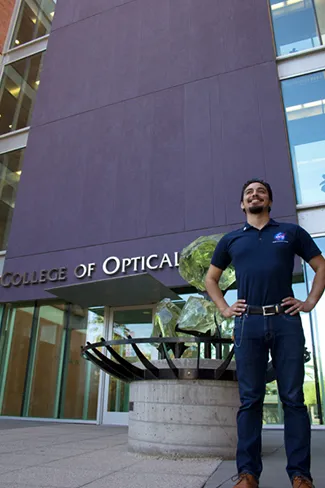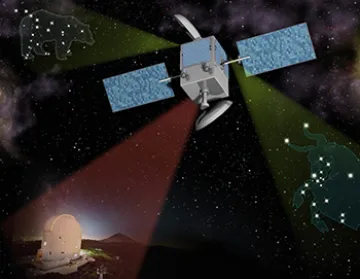Another Wavelength: Andrew Rocha

This month on Another Wavelength, we learn more about East Los Angeles native Andrew Rocha, a third-year Bachelor of Science in Optical Sciences and Engineering student who was recently awarded the James M. Palmer Endowed Scholarship in Optical Sciences.

What brought you to optics?
After going back to school in the fall of 2010, I took a career counseling class to figure out my plans for the future and, in that class, I was recommended optical engineering as a career path. I didn’t know what it was and when I read the description, I thought it sounded boring. It stated things such as, “… designs lenses, photodetectors, optical fibers ….” Then the last part of the description said “… designs lasers,” and that made me excited to learn more, so the following semester I began my new academic journey. I also took my first physics course in the spring of 2011 with a professor who also worked as an electro-optical engineer at JPL. He became my mentor and I took three more physics courses with him. Last year, I was selected to participate in an educational program at JPL and got to take a tour of his lab. I am still hooked on lasers and aspire to conduct space-related research after earning a Ph.D. in laser science.
Who would you call your science hero?
Bill Nye the Science Guy, who spent a good portion of his life increasing STEM awareness among the public and encouraging children to get excited about STEM. Now, as the CEO of Planetary Society, he is supporting the cause of space exploration. I believe that all students should have a positive exposure to STEM in order to live a happier life exploring their interests as they mature. I hope that wherever life takes me, I can be a positive role model like Bill was for me.
Describe your research in 20 words or fewer.
For UA, experimental chalcogenide fiber optics and whispering-gallery modes in glass microspheres. For NASA, laser guide star implementation study.
Describe your research in 200 words or fewer.
Within the UA, I work with Dr. Pierre Lucas in the Material Science Department.
- Characterization of a variety of chalcogenide glass fibers to determine absorbance in the mid-IR range with a tunable quantum cascade laser. The application would utilize evanescent waves in a tapered region to produce higher optical power allowing for higher resolution detection of the vibrational signatures of chemical and biological samples.
- Whispering-gallery modes on doped glass microspheres with 300 μm radius’ are measured in a modified confocal microscope. The efficient pumping/detecting scheme involves focusing a laser in the microsphere and exciting the ions of the microsphere material. The fluorescent emission of the microsphere produces the whispering gallery modes. The microspheres were produced in collaboration with Dr. Khanh Kieu at OSC.


For NASA, I work with Dr. Aaron Swank testing a revolutionary beaconless pointing system for deep space optical communication. We would like to verify the pointing performance of the optical communications system. The system would be a portable 2W 589 nm laser and telescope and vibration isolation technology on a weather balloon. The laser would be used to excite the D1 gap in sodium from the abundant sodium layer in our atmosphere at 90 km. The beam energy would be converted to fluorescent radiation to project a level five apparent magnitude star which will then be collected by the telescope.
Name three neat facts about you.
-
I bought a running 1989 Volvo 240 station wagon for $600 with 204k miles. I named him WALL-E because I replaced almost everything I could from the junkyard, and he is still running. He currently has 276k miles and started on the first try after sitting in a parking lot all summer in Tucson.
-
I have met four astronauts. Buzz Aldrin and Mark Kelly were unplanned and I have autographs from Buzz Aldrin, Mike Foreman, and Doug H. Wheelock. During my internship at NASA, Janet Kavandi became my mentor to help me become a strong candidate for the NASA astronaut program.
-
I completed a marathon in 2009. I started training six months before the race, having never completed a running event or run more than a mile before. I ended up having to limp the last six miles because I incurred three injuries during the 4:45 hour race.
